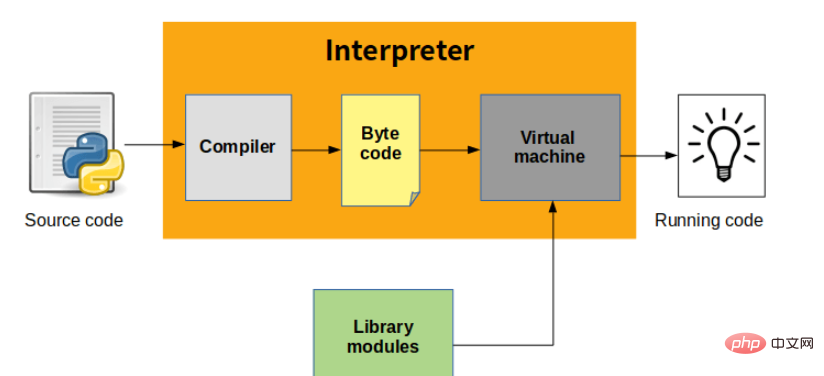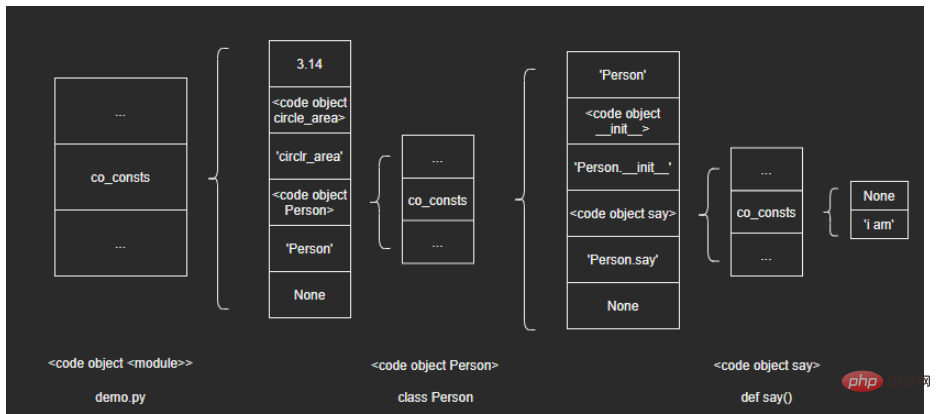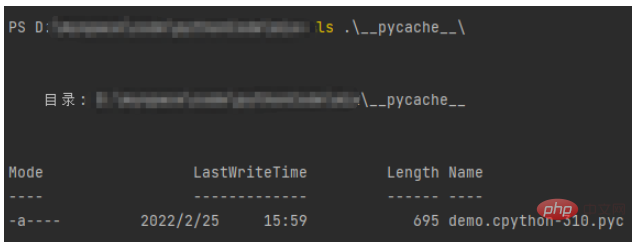Rumah >pembangunan bahagian belakang >Tutorial Python >Proses pelaksanaan program Python termasuk menukar kod sumber kepada kod bait (iaitu kompilasi) dan melaksanakan kod bait
Proses pelaksanaan program Python termasuk menukar kod sumber kepada kod bait (iaitu kompilasi) dan melaksanakan kod bait
- WBOYWBOYWBOYWBOYWBOYWBOYWBOYWBOYWBOYWBOYWBOYWBOYWBke hadapan
- 2023-05-09 16:37:092258semak imbas
Soalan:
Kami perlu menulis beberapa program Python setiap hari, sama ada untuk memproses beberapa teks atau untuk melakukan beberapa kerja pengurusan sistem. Selepas atur cara ditulis, anda hanya perlu menaip arahan python untuk memulakan atur cara dan mula melaksanakannya:
$ python some-program.py
Jadi, bagaimanakah fail teks .py ditukar langkah demi langkah menjadi satu yang boleh dilaksanakan oleh CPU? Bagaimana dengan arahan mesin? Selain itu, fail .pyc mungkin dijana semasa pelaksanaan program Apakah fungsi fail ini?
1. Proses pelaksanaan
Walaupun Python kelihatan lebih seperti bahasa yang ditafsirkan seperti skrip Shell dari segi tingkah laku, sebenarnya, prinsip pelaksanaan program Python pada asasnya sama dengan Java atau C# dan boleh diringkaskan untuk mesin maya dan kod bait. Python melaksanakan program dalam dua langkah: mula-mula menyusun kod atur cara menjadi kod bait, dan kemudian mulakan mesin maya untuk melaksanakan kod bait:

Walaupun arahan Python juga dipanggil Jurubahasa Python , tetapi pada asasnya berbeza daripada penterjemah bahasa skrip lain. Sebenarnya, penterjemah Python terdiri daripada dua bahagian: pengkompil dan mesin maya. Apabila jurubahasa Python dimulakan, ia melakukan dua langkah berikut terutamanya:
Pengkompil menyusun kod sumber Python dalam fail .py ke dalam kod bait Mesin maya melaksanakan kod bait yang dijana oleh pengkompil baris demi baris
Oleh itu, pernyataan Python dalam fail .py tidak ditukar terus kepada arahan mesin, tetapi kepada kod bait Python.
2. Bytecode
Hasil kompilasi program Python ialah bytecode, yang mengandungi banyak kandungan berkaitan tentang pengendalian Python. Oleh itu, sama ada untuk mempunyai pemahaman yang lebih mendalam tentang mekanisme pengendalian mesin maya Python atau untuk mengoptimumkan kecekapan pengendalian program Python, bytecode ialah kandungan utama. Jadi, apakah rupa Python bytecode? Bagaimanakah kita boleh mendapatkan bytecode program Python? Python menyediakan kompilasi fungsi terbina dalam untuk kompilasi segera kod sumber. Kita hanya perlu memanggil fungsi kompilasi dengan kod sumber untuk disusun sebagai parameter untuk mendapatkan hasil kompilasi kod sumber.
3. Penyusunan kod sumber
Seterusnya, kami menyusun atur cara melalui fungsi penyusunan:
Kod sumber disimpan dalam fail demo.py:
PI = 3.14
def circle_area(r):
return PI * r ** 2
class Person(object):
def __init__(self, name):
self.name = name
def say(self):
print('i am', self.name) Kompil Sebelum ini, kod sumber perlu dibaca daripada fail:
>>> text = open('D:\myspace\code\pythonCode\mix\demo.py').read()
>>> print(text)
PI = 3.14
def circle_area(r):
return PI * r ** 2
class Person(object):
def __init__(self, name):
self.name = name
def say(self):
print('i am', self.name)dan kemudian fungsi kompil dipanggil untuk menyusun kod sumber:
>>> result = compile(text,'D:\myspace\code\pythonCode\mix\demo.py', 'exec')
Terdapat 3 parameter yang diperlukan untuk fungsi penyusunan:
sumber : Kod sumber yang akan disusun
nama fail: nama fail di mana kod sumber terletak
mod: mod penyusunan, exec bermaksud menyusun kod sumber sebagai modul
Tiga mod kompilasi:
exec: digunakan untuk menyusun kod sumber modul
single: digunakan untuk menyusun pernyataan Python tunggal (secara interaktif)
eval: digunakan untuk menyusun ungkapan eval
4. PyCodeObject
Melalui fungsi kompilasi, kami mendapat hasil penyusunan kod sumber akhir:
>>> result <code object <module> at 0x000001DEC2FCF680, file "D:\myspace\code\pythonCode\mix\demo.py", line 1> >>> result.__class__ <class 'code'>
Akhirnya kami mendapat kod jenis objek, dan struktur asasnya yang sepadan ialah PyCodeObject
Kod sumber PyCodeObject adalah seperti berikut:
/* Bytecode object */
struct PyCodeObject {
PyObject_HEAD
int co_argcount; /* #arguments, except *args */
int co_posonlyargcount; /* #positional only arguments */
int co_kwonlyargcount; /* #keyword only arguments */
int co_nlocals; /* #local variables */
int co_stacksize; /* #entries needed for evaluation stack */
int co_flags; /* CO_..., see below */
int co_firstlineno; /* first source line number */
PyObject *co_code; /* instruction opcodes */
PyObject *co_consts; /* list (constants used) */
PyObject *co_names; /* list of strings (names used) */
PyObject *co_varnames; /* tuple of strings (local variable names) */
PyObject *co_freevars; /* tuple of strings (free variable names) */
PyObject *co_cellvars; /* tuple of strings (cell variable names) */
/* The rest aren't used in either hash or comparisons, except for co_name,
used in both. This is done to preserve the name and line number
for tracebacks and debuggers; otherwise, constant de-duplication
would collapse identical functions/lambdas defined on different lines.
*/
Py_ssize_t *co_cell2arg; /* Maps cell vars which are arguments. */
PyObject *co_filename; /* unicode (where it was loaded from) */
PyObject *co_name; /* unicode (name, for reference) */
PyObject *co_linetable; /* string (encoding addr<->lineno mapping) See
Objects/lnotab_notes.txt for details. */
void *co_zombieframe; /* for optimization only (see frameobject.c) */
PyObject *co_weakreflist; /* to support weakrefs to code objects */
/* Scratch space for extra data relating to the code object.
Type is a void* to keep the format private in codeobject.c to force
people to go through the proper APIs. */
void *co_extra;
/* Per opcodes just-in-time cache
*
* To reduce cache size, we use indirect mapping from opcode index to
* cache object:
* cache = co_opcache[co_opcache_map[next_instr - first_instr] - 1]
*/
// co_opcache_map is indexed by (next_instr - first_instr).
// * 0 means there is no cache for this opcode.
// * n > 0 means there is cache in co_opcache[n-1].
unsigned char *co_opcache_map;
_PyOpcache *co_opcache;
int co_opcache_flag; // used to determine when create a cache.
unsigned char co_opcache_size; // length of co_opcache.
};Objek kod PyCodeObject digunakan untuk menyimpan hasil kompilasi, termasuk kod bait dan pemalar, nama, dsb. terlibat dalam kod. Medan utama termasuk:
| 字段 | 用途 |
|---|---|
| co_argcount | 参数个数 |
| co_kwonlyargcount | 关键字参数个数 |
| co_nlocals | 局部变量个数 |
| co_stacksize | 执行代码所需栈空间 |
| co_flags | 标识 |
| co_firstlineno | 代码块首行行号 |
| co_code | 指令操作码,即字节码 |
| co_consts | 常量列表 |
| co_names | 名字列表 |
| co_varnames | 局部变量名列表 |
下面打印看一下这些字段对应的数据:
通过co_code字段获得字节码:
>>> result.co_code b'd\x00Z\x00d\x01d\x02\x84\x00Z\x01G\x00d\x03d\x04\x84\x00d\x04e\x02\x83\x03Z\x03d\x05S\x00'
通过co_names字段获得代码对象涉及的所有名字:
>>> result.co_names ('PI', 'circle_area', 'object', 'Person')
通过co_consts字段获得代码对象涉及的所有常量:
>>> result.co_consts (3.14, <code object circle_area at 0x0000023D04D3F310, file "D:\myspace\code\pythonCode\mix\demo.py", line 3>, 'circle_area', <code object Person at 0x0000023D04D3F5D0, file "D:\myspace\code\pythonCode\mix\demo.py", line 6>, 'Person', None)
可以看到,常量列表中还有两个代码对象,其中一个是circle_area函数体,另一个是Person类定义体。对应Python中作用域的划分方式,可以自然联想到:每个作用域对应一个代码对象。如果这个假设成立,那么Person代码对象的常量列表中应该还包括两个代码对象:init函数体和say函数体。下面取出Person类代码对象来看一下:
>>> person_code = result.co_consts[3] >>> person_code <code object Person at 0x0000023D04D3F5D0, file "D:\myspace\code\pythonCode\mix\demo.py", line 6> >>> person_code.co_consts ('Person', <code object __init__ at 0x0000023D04D3F470, file "D:\myspace\code\pythonCode\mix\demo.py", line 7>, 'Person.__init__', <code object say at 0x0000023D04D3F520, file "D:\myspace\code\pythonCode\mix\demo.py", line 10>, 'Person.say', None)
因此,我们得出结论:Python源码编译后,每个作用域都对应着一个代码对象,子作用域代码对象位于父作用域代码对象的常量列表里,层级一一对应。

至此,我们对Python源码的编译结果——代码对象PyCodeObject有了最基本的认识,后续会在虚拟机、函数机制、类机制中进一步学习。
5. 反编译
字节码是一串不可读的字节序列,跟二进制机器码一样。如果想读懂机器码,可以将其反汇编,那么字节码可以反编译吗?
通过dis模块可以将字节码反编译:
>>> import dis >>> dis.dis(result.co_code) 0 LOAD_CONST 0 (0) 2 STORE_NAME 0 (0) 4 LOAD_CONST 1 (1) 6 LOAD_CONST 2 (2) 8 MAKE_FUNCTION 0 10 STORE_NAME 1 (1) 12 LOAD_BUILD_CLASS 14 LOAD_CONST 3 (3) 16 LOAD_CONST 4 (4) 18 MAKE_FUNCTION 0 20 LOAD_CONST 4 (4) 22 LOAD_NAME 2 (2) 24 CALL_FUNCTION 3 26 STORE_NAME 3 (3) 28 LOAD_CONST 5 (5) 30 RETURN_VALUE
字节码反编译后的结果和汇编语言很类似。其中,第一列是字节码的偏移量,第二列是指令,第三列是操作数。以第一条字节码为例,LOAD_CONST指令将常量加载进栈,常量下标由操作数给出,而下标为0的常量是:
>>> result.co_consts[0]3.14
这样,第一条字节码的意义就明确了:将常量3.14加载到栈。
由于代码对象保存了字节码、常量、名字等上下文信息,因此直接对代码对象进行反编译可以得到更清晰的结果:
>>>dis.dis(result)
1 0 LOAD_CONST 0 (3.14)
2 STORE_NAME 0 (PI)
3 4 LOAD_CONST 1 (<code object circle_area at 0x0000023D04D3F310, file "D:\myspace\code\pythonCode\mix\demo.py", line 3>)
6 LOAD_CONST 2 ('circle_area')
8 MAKE_FUNCTION 0
10 STORE_NAME 1 (circle_area)
6 12 LOAD_BUILD_CLASS
14 LOAD_CONST 3 (<code object Person at 0x0000023D04D3F5D0, file "D:\myspace\code\pythonCode\mix\demo.py", line 6>)
16 LOAD_CONST 4 ('Person')
18 MAKE_FUNCTION 0
20 LOAD_CONST 4 ('Person')
22 LOAD_NAME 2 (object)
24 CALL_FUNCTION 3
26 STORE_NAME 3 (Person)
28 LOAD_CONST 5 (None)
30 RETURN_VALUE
Disassembly of <code object circle_area at 0x0000023D04D3F310, file "D:\myspace\code\pythonCode\mix\demo.py", line 3>:
4 0 LOAD_GLOBAL 0 (PI)
2 LOAD_FAST 0 (r)
4 LOAD_CONST 1 (2)
6 BINARY_POWER
8 BINARY_MULTIPLY
10 RETURN_VALUE
Disassembly of <code object Person at 0x0000023D04D3F5D0, file "D:\myspace\code\pythonCode\mix\demo.py", line 6>:
6 0 LOAD_NAME 0 (__name__)
2 STORE_NAME 1 (__module__)
4 LOAD_CONST 0 ('Person')
6 STORE_NAME 2 (__qualname__)
7 8 LOAD_CONST 1 (<code object __init__ at 0x0000023D04D3F470, file "D:\myspace\code\pythonCode\mix\demo.py", line 7>)
10 LOAD_CONST 2 ('Person.__init__')
12 MAKE_FUNCTION 0
14 STORE_NAME 3 (__init__)
10 16 LOAD_CONST 3 (<code object say at 0x0000023D04D3F520, file "D:\myspace\code\pythonCode\mix\demo.py", line 10>)
18 LOAD_CONST 4 ('Person.say')
20 MAKE_FUNCTION 0
22 STORE_NAME 4 (say)
24 LOAD_CONST 5 (None)
26 RETURN_VALUE
Disassembly of <code object __init__ at 0x0000023D04D3F470, file "D:\myspace\code\pythonCode\mix\demo.py", line 7>:
8 0 LOAD_FAST 1 (name)
2 LOAD_FAST 0 (self)
4 STORE_ATTR 0 (name)
6 LOAD_CONST 0 (None)
8 RETURN_VALUE
Disassembly of <code object say at 0x0000023D04D3F520, file "D:\myspace\code\pythonCode\mix\demo.py", line 10>:
11 0 LOAD_GLOBAL 0 (print)
2 LOAD_CONST 1 ('i am')
4 LOAD_FAST 0 (self)
6 LOAD_ATTR 1 (name)
8 CALL_FUNCTION 2
10 POP_TOP
12 LOAD_CONST 0 (None)
14 RETURN_VALUE操作数指定的常量或名字的实际值在旁边的括号内列出,此外,字节码以语句为单位进行了分组,中间以空行隔开,语句的行号在字节码前面给出。例如PI = 3.14这个语句就被会变成了两条字节码:
1 0 LOAD_CONST 0 (3.14)
2 STORE_NAME 0 (PI)6. pyc
如果将demo作为模块导入,Python将在demo.py文件所在目录下生成.pyc文件:
>>> import demo

pyc文件会保存经过序列化处理的代码对象PyCodeObject。这样一来,Python后续导入demo模块时,直接读取pyc文件并反序列化即可得到代码对象,避免了重复编译导致的开销。只有demo.py有新修改(时间戳比.pyc文件新),Python才会重新编译。
因此,对比Java而言:Python中的.py文件可以类比Java中的.java文件,都是源码文件;而.pyc文件可以类比.class文件,都是编译结果。只不过Java程序需要先用编译器javac命令来编译,再用虚拟机java命令来执行;而Python解释器把这两个过程都完成了。
Atas ialah kandungan terperinci Proses pelaksanaan program Python termasuk menukar kod sumber kepada kod bait (iaitu kompilasi) dan melaksanakan kod bait. Untuk maklumat lanjut, sila ikut artikel berkaitan lain di laman web China PHP!

